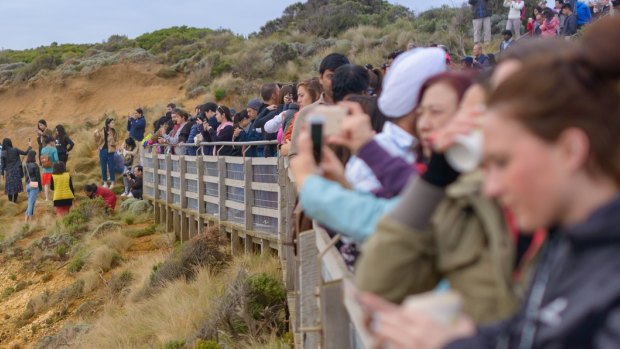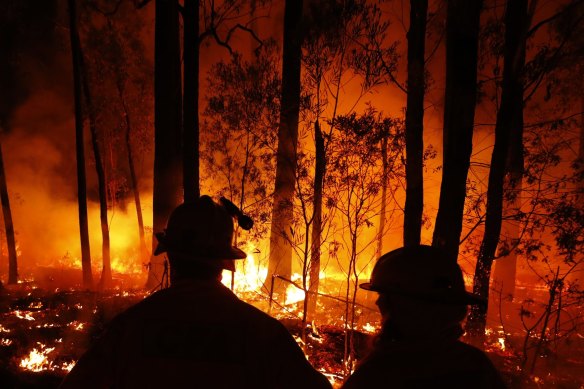This was published 3 years ago
Victorian tourism and coronavirus: State set to lose $10.5 billion

Tourists pose for photos outside the designated viewing area for the Twelve Apostles at Port Campbell. But the coronavirus pandemic has brought tourism to a halt.
Tourism-dependent communities are bracing for losses exceeding $10 billion as the coronavirus pandemic and summer’s bushfires combine to inflict massive economic damage.
The Department of Jobs, Precincts and Regions estimates that the reduction in visitor expenditure for the first half of this year will be $10.5 billion due to bushfires and coronavirus, including $3.8 billion in regional Victoria.
The state government is expected to announce a plan within days to ease coronavirus travel restrictions but tourism bodies say many residents in towns popular with tourists remain worried about the health risks.
Day trips are allowed in Victoria but overnight stays are still banned. Other states have begun reopening accommodation to kickstart their tourism sectors.
Economic modelling commissioned by Tourism North East showed that between $341 million and $431 million could be lost in the three months to June alone. Job losses are forecast to climb as high as 4300.
This comes on top of losses sustained in the March quarter estimated to range from $158 million to $208 million.

First the bushfires and now the pandemic have had a devastated economic impact on Gippsland's tourism sector. Credit: Getty Images
Tourism North East chief executive Bess Nolan-Cook said tourism businesses in the region had just started recovering from the bushfires when social restrictions were introduced, grinding trade to a halt.
“People are really hurting,” she said. “2020 has been a shocker for us.”
Ms Nolan-Cook said businesses dependent on the tourism trade had hoped a busy autumn would help them survive the bushfire damage.
“Autumn is one of our key seasons. It was pretty devastating to have COVID-19 come along.”
The region has largely escaped coronavirus infections but Ms Nolan-Cook called for a cautious approach to opening up to trade.
She was keen to see visitors return safely but insisted the local tourism sector needed community support.
“We’ve got to get people moving around their own communities as a first step,” she said. “The next phase is getting people moving around the state.”
Great Ocean Road Regional Tourism chairman Wayne Kayler-Thomson said the region was preparing to lose as much as $1.3 billion in visitor expenditure this year.
“It’s terribly upsetting. This is devastation,” he said.
Mr Kayler-Thomson said it would take years for local economies to rebuild their businesses after visitor numbers plummeted.
He said the summer was quieter than usual because international visitors were deterred by news of the bushfires in East Gippsland and Victoria’s north-east.
The pandemic then put a stop to the tourism industry altogether.
“Our projection is that we will not recover to pre-pandemic levels of visitation until at least 2022/23.”
Mr Kayler-Thomson said 2000 businesses employing 12,000 people in the Great Ocean Road region were entirely dependent on the visitor economy.
He predicted between 10 per cent and 20 per cent may not survive.
However, he insisted communities were not yet ready for a major visitor influx.
“Our communities don’t want to be impacted by increases of visitors if there are health risks.”
Phillip Island’s travel sector has also suffered massive losses.
Destination Phillip Island Regional Tourism Board general manager Kim Storey said the Penguin Parade alone attracted 600,000 international visitors every year.
“That’s all come to a stop,” she said.
The board estimates there will be a 45 per cent drop in visitors across the region this year, which would equate to about $260 million in losses compared to last year. It also forecasts job losses may reach 25 per cent.
This week The Age revealed the tourism sector in Gippsland is losing more than $180 million a month, with total losses amounting to almost $750 million so far this year, including the impact from the bushfires.
Sign up for the Traveller newsletter
The latest travel news, tips and inspiration delivered to your inbox. Sign up now.